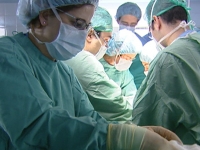Health
The Council of Europe recognizes the role of doctors in the organ donation
European Organ Donor Day is celebrated
This year's tribute to European donors has been preceded by an important resolution in which the Council of Europe recognizes the role of doctors of Emergency and Critical Care in the organ donation. These professionals are a key element of the Spanish model of transplantation. Driven by Spain, this resolution has been endorsed by 37 countries. Here the member states of the Council of Europe to train emergency physicians and intensive care in all matters relating to the process of organ donation (detection of potential donor, crisis communications, evaluation and maintenance of the donor and determination is recommended death) as a way to increase donations.
The Spanish transplant system has long had with the doctors of Emergency and Critical Care as key professionals in improving organ donation. The National Trasplant Organization (ONT its Spanish acronym) has already trained more than 1,000 young intensivists during their period of residence on donation and transplants and nearly 6,000 professional accident and emergency, thanks to agreements signed with the Spanish Society of Intensive and Critical Care Medicine (SEMICYUC) and the Spanish Society of Emergency Medicine (SEMES). Today these specialists are some of the greatest allies donation system throughout Spain.
The Council resolution also urges Europe to incorporate organ donation as a usual activity in the daily routine of ICUs and emergency services, with assessment results through quality indicators and audits. A line of work that the Spanish transplant system has developed in all hospitals across the country. The Council of Europe also recommends creating within ICUs figure of the transplant coordinator or a professional reference intensive, responsible for potential donors, but in the donation process involving all members of the unit.
The transplant coordinator is one of the key elements of the Spanish model of transplantation and their work is crucial in improving donations. According to data from the ONT, in Spain 87% of hospital medical coordinators are intensivists, although in practice the entire ICU team collaborates in the process of organ donation. Finally, it advises develop research programs on donation in ICU and ER, an aspect which makes the ONT long, together with the SEMICIYUC and SEMES.
This resolution is a resounding recognition of the effectiveness of the Spanish transplant system, with 36 donors per million population (pmp) in 2014 maintains its world leadership without interruption for 23 years, with a higher than average rate of European Union and the United States. Spain last year accounted for 16.8% of European grants, as 1,680 of the 10,033 registered donors in the EU in 2014 were Spanish.
Number of donors is growing
In the EU the number of donors is growing very slowly, but steadily, and has gone from a rate of 18.3 donors pmp pmp in 2009 to 19.6 in 2014. However, despite this slight increase, large differences between European countries, even among those most developed: data from the World Transplant Registry show a significant improvement in organ donation in those countries that have implemented the Spanish model of transplantation in whole or in part.
This is the case of Croatia, which has gone from 17.7 donors pmp in 2009 to 35.1 donors pmp in 2014, and Portugal (27.3 donors pmp), countries that have fully developed a system of donation and transplants like to Spanish. The same applies to the UK, it has achieved in the past year 20.6 donors pmp, compared to 12 donors pmp that recorded in 2009, after incorporating the figure responsible for transplants in ICUs and involving intensivists in the donation process. On the opposite side, Germany stresses, whose donation rate has fallen by more than 30% in the last five years, going from 14.9 donors pmp in 2009 to 10.4 donors pmp in 2014.
Liability for this article lies with the author, who also holds the copyright. Editorial content from USPA may be quoted on other websites as long as the quote comprises no more than 5% of the entire text, is marked as such and the source is named (via hyperlink).






